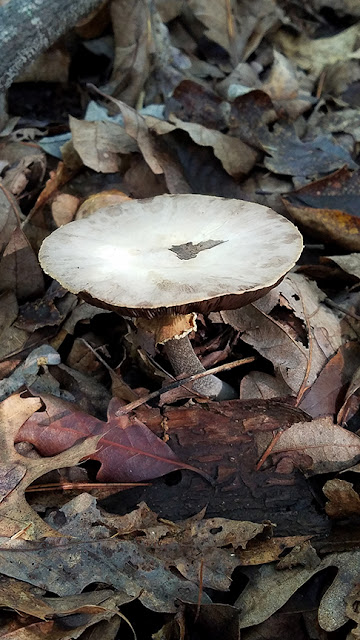 |
Splinter Hill Bog in Alabama.
|
In October I attended the annual American Society of Botanical Artists (ASBA) Conference, which this year was held in Mobile, AL. One of the activities that interested me the most was a day of botanical sketching at the famous Splinter Hill Bog, about an hour north of the city. We were informed that this area, which normally has the highest amount of rainfall in the nation, had been in drought conditions all summer, with no measurable rainfall in months. The bog was as dry as it could be!
The Nature Conservancy, which owns this preserve, does prescribed burns periodically in order to maintain the condition of this Long-leaf pine savannah, and had done one in early March. The Long-leaf pine bark is resistant to fire, and the pitcher plants have underground rhizomes that allow them survive these burns, but they die to the ground and need rain to sprout back, and that hadn't happened much this year.
Before going out to find the plants we were to sketch, Judy Stout, a volunteer with the Mobile Botanic Garden, spoke to us about the specific plant communities found in this unique bog, and passed around some drawings to explain how the pitcher plants trap their insect food. She then demonstrated by splitting one of the pitcher plant leaves to show us the insects inside in different stages of being digested.
 |
Insects inside a pitcher plant leaf.
|
 |
Walking into the bog.
|
We walked around for a bit looking at the White-topped pitcher plants (Sarracenia leucophylla) for which this site is most famous; unfortunately many of them were brown and dry. We saw another type of pitcher plant--a decumbent variety, Sarracenia rosea, as well as a clubmoss with fruiting stems on their ends. There were no sundews (Drosera genus) anywhere to be seen, it had been too dry for these plants to regenerate.
 |
White-topped pitcher plants (Sarracenia leucophylla)
|
 |
Decumbent pitcher plant (Sarracenia rosea)
|
 |
Clubmoss with lighter fruiting stems on top (Lycopodium alopecuroides)
|
There were many other wildflowers typical of the fall season blooming that I could identify by genus, but getting the right species is another matter: purple Gerardia (Agalinis purpurea), swamp sunflowers (Helianthus angustifolia), wild ageratum (Conoclinium coelestinum), four-sided milkwort (Polygala cruciata), a tiny Lobelia (Lobelia ? ), a very narrow-leaved goldenrod and a yellow flower with pinked petals (tickseed?).
 |
Purple gerardia (Agalinis purpurea)
|
 |
Swamp sunflowers and Pineland bogbuttons (Lauchnocaulon anceps)
|
 |
Wild ageratum (Conoclinium coelestinum)
|
One curious flower called Pineland bogbuttons (Lachnocaulon anceps) was completely new to me, and I couldn't begin to identify any of the grasses that carpeted the long-leaf pine savannah, I'll leave that to experts.
 |
Lobelia syphillitica?
|
 |
| Four-sided milkwort (Polygala cruciata) and my sketch side by side. |
|
|
|
 |
| Very narrow-leaved Goldenrod |
 |
Tickseed (Coreopsis linifolia?)
|
 |
Bracken fern with no ID flower stalks
|
There was so much to see and explore it was hard to settle down to sketching, but I finally did, and chose to sketch some of the abundant White-topped pitcher plants. I found one dry pitcher plant flower in the morning.
 |
White-topped pitcher plant sketches.
|
After our lunch break, we switched instructors to continue, and Lara Call Gastinger, pointed me toward one lone pitcher plant flower that still had some of its vivid colors, although the petals had fallen. I wanted to include this in my pitcher plant sketches, since the flower has such peculiar structures.
 |
| Dried pitcher plant flower. |
|
 |
White-topped pitchers
|
 |
Colorful Pitcher plant flower
|
 |
My sketch of the pitcher plant flower
|
A little before three in the afternoon, we were rounded up to share our day's work and get ready to go back in the bus that had brought us here from Mobile. It was fascinating to see what everyone else had done--I wish I could have photographed every one of the sketchbooks, but here's a sampling of some.
 |
Sketches from the class
|
 |
More class sketches
|
 |
Lara Call Gastinger's sketchbook
|
 |
Another sketchbook with purple gerardia and pineland bogbutton flowers.
|
All day I'd worn my Wellington boots, thinking they'd keep my feet dry--and the bog was so dry I didn't need them at all!
On the drive back home from Mobile a few days later, I stopped by the bog again, to allow my friend and travel companion Ann to see it. This time, since we weren't sketching, I had a chance to walk further into the preserve, and found another type of pitcher plant I hadn't seen a few days before -- the Parrot pitcher plant (Sarracenia psittacina), which I identified thanks to my visit to the Mobile Botanic Gardens and their miniature bog, which had been watered regularly. They had some lovely sundews in there too.
The distinct species of pitcher plants at the Splinter Hill Bog have
hybridized over time and one can see so many variations in color and
hybrids sporting the characteristics of two or more species... what a
fabulous natural laboratory! Oddly enough, no one has done a
comprehensive botanical survey of all of the plants found at this
location; I hope eventually some enterprising young botanists will do
just that.
 |
Parrot pitcher plant (Sarracenia psittacina)
|
I'd love to return to this beautiful bog some day, and see it in its full glory.






























































